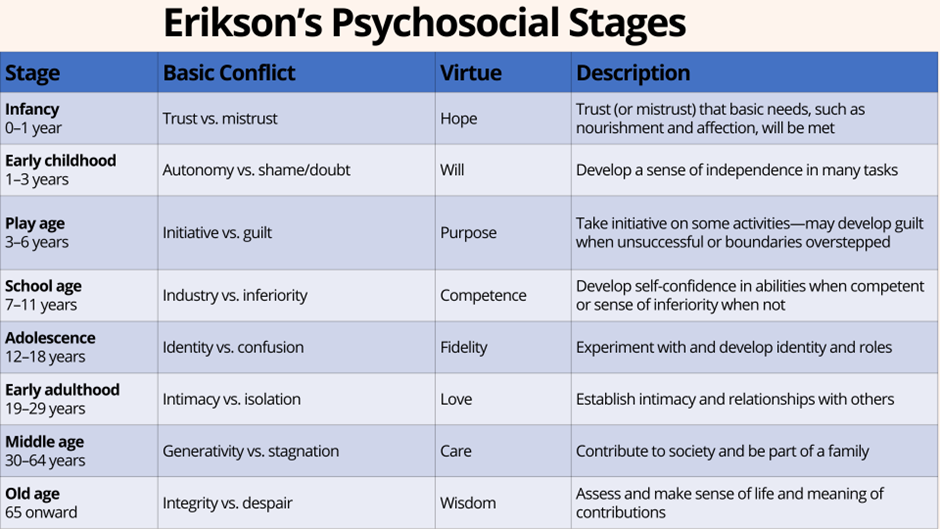A nurse is caring for an adolescent. The nurse should expect that the adolescent is working on which of the following developmental tasks?
Defining a sense of self
Learning to perform tasks independently
Learning to use creative energies
Building a sense of trust
The Correct Answer is A
A. Defining a sense of self: Adolescence is characterized by the search for identity and defining a sense of self. Erikson identifies this stage as "Identity vs. Role Confusion," where individuals explore and form their own identity separate from their family and childhood roles.
B. Learning to perform tasks independently: This is more typical of early childhood (Erikson's "Autonomy vs. Shame and Doubt"). During this stage, children are learning basic independence, such as dressing and feeding themselves.
C. Learning to use creative energies: This task is more relevant to the preschool age group (Erikson's "Initiative vs. Guilt"), where children engage in imaginative play and begin exploring their own ideas and creativity.
D. Building a sense of trust: Building a sense of trust is the primary task in infancy (Erikson's "Trust vs. Mistrust"), where infants develop trust in their caregivers and the world around them.

Nursing Test Bank
Naxlex Comprehensive Predictor Exams
Related Questions
Correct Answer is C
Explanation
Inject insulin in the deltoid muscle: Insulin is administered subcutaneously, not intramuscularly. Common sites for insulin injection include the abdomen, thighs, and upper arms.
B. Take glyburide with breakfast: Glyburide is an oral hypoglycemic agent used for type 2 diabetes, not type 1 diabetes. Adolescents with type 1 diabetes require insulin.
C. Obtain an influenza vaccine annually: People with diabetes are at higher risk for complications from influenza, so annual vaccination is recommended to prevent illness.
D. Administer glucagon for hyperglycemia: Glucagon is used to treat severe hypoglycaemia, not hyperglycaemia. For hyperglycemia, insulin administration and monitoring blood glucose levels are key.
Correct Answer is B
Explanation
A. Hepatitis B (HBV): The Hepatitis B vaccine is typically completed in the infant stage, and a 5-year-old with up-to-date vaccinations would not need a booster for school entry. This is not included in the pre-kindergarten vaccine schedule.
B. Measles, mumps, and rubella (MMR): The MMR vaccine is part of the pre-kindergarten immunization schedule. A second dose is recommended between ages 4 and 6 to ensure immunity before school entry.
C. Haemophilus influenzae type B (Hib): The Hib vaccine is typically administered to infants and young children, and a 5-year-old with up-to-date immunizations would already be fully vaccinated against Hib. No booster is required at this age.
D. Pneumococcal conjugate vaccine (PCV): The PCV vaccine series is usually completed in infancy, and a 5-year-old with current vaccinations would not require a booster. This vaccine is not part of the pre-kindergarten schedule.
Whether you are a student looking to ace your exams or a practicing nurse seeking to enhance your expertise , our nursing education contents will empower you with the confidence and competence to make a difference in the lives of patients and become a respected leader in the healthcare field.
Visit Naxlex, invest in your future and unlock endless possibilities with our unparalleled nursing education contents today
Report Wrong Answer on the Current Question
Do you disagree with the answer? If yes, what is your expected answer? Explain.
Kindly be descriptive with the issue you are facing.
